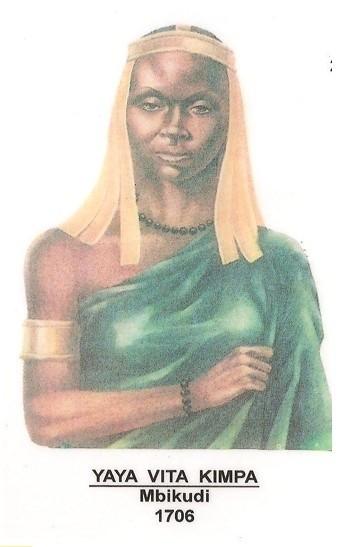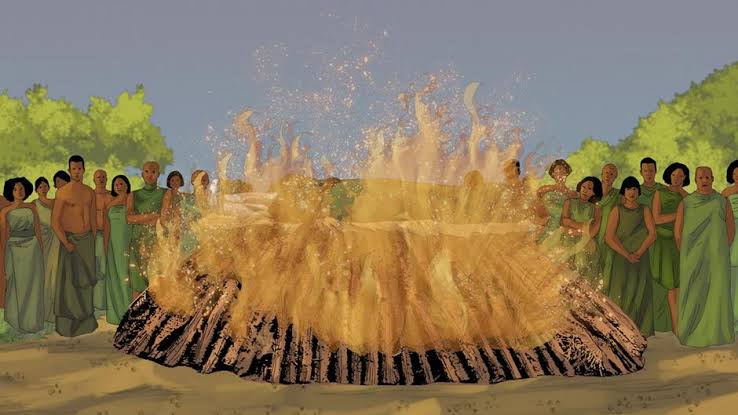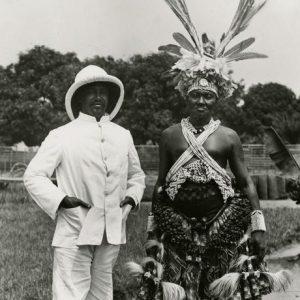KIMPA VITA KONGO DIA NTOTILA 1684-1706!
During the pre-colonial period, Africa knew a woman named Kimpa Vita, a young revolutionary from the Kingdom of Kongo (near modern day Angola) who had unified the kingdom by establishing the revolutionary Antonianist movement. Antonianism was composed of Christian beliefs and black, traditional Kongo beliefs. She was a very strong woman of 20 to 22 years of age, who was able to stand up to European domination. In this article we will find out:

- Her Childhood
- The context in which she was born
- The call to the mission
- Kimpa Vita and the Anthonianism mouvement
- Her death
- Her achievements
Childhood
Kimpa Vita was born in Mbanza Kongo, the capital of the Kingdom of Kongo (in modern day Angola) in 1684 into a Catholic family. She was baptized at a very young age and was given the name Dona Beatriz, her Portuguese name.
As a young woman, she was dedicated to spirituality and prayed in a group of young women and men in the church, the Kintuadi Saint Anthony parish. She was trained to become a Nganga Marinda, an intermediary between the world of the living and the spirits. She delivered people in her youth, and was soon considered a prophet.

The Context in which she was born
The group of young people in which Kimpa Vita prayed had a mission to pray for the Kongo Kingdom, which had just lost its King, Mvita a Nkanga, at the battle of Mbwila in 1665. In this time, the Kongolese State was in a chaotic situation, following a discord between the Portuguese and the Kongolese, especially the King Mvita a Nkanga, who was against the slave trade that the Portuguese controlled exorbitantly. After the King was killed, the kingdom was unstable, divided, and the people no longer lived in the capital city, Mbanza Kongo.
So this group of young people led by Kimpa Vita had given themselves the mission to pray for the Kongo kingdom and that God, Nzambi in Kikongo, could help them. Being in a Catholic church, the priests did not agree with this kind of prayer and finally sent away the young woman Kimpa Vita and her group. They continued to pray outside the church, and during their prayer sessions, Kimpa Vita prophesied and delivered people.
The Call to Mission
It is said that at the age of 20, Kimpa Vita fell very ill. After some immediate care, her health continued to deteriorate until she was eventually pronounced dead. Three days later she came back to life. One might relate this to the story of Jesus in the Bible. For Kimpa Vita, however, the story tells that she went to the kingdom of the ancestors or spirits.
She met the spirits called ancestors of the mystical conclave or the holy Kongo and the holy Antoine; they entrusted her a special mission: That of reunifying the Kingdom of Kongo through a black Christianity, thus a combination of Christianity and Kongo beliefs. Her missions were to restore the Kingdom, to rebuild the capital city of Mbanza Kongo, and to designate a new king.

Kimpa Vita and the Anthonianism mouvement
After her resurrection, Kimpa Vita claimed to be the reincarnation of Antonio de Padua, a Franciscan priest of the 1100s, and began to preach and fulfill the mission entrusted to her in the invisible world.
This is how the Antonianist movement was created around 1704 by Kimpa Vita. Many people followed the African revolutionary as she gathered people and built houses in Mbanza Kongo. She organized prayers and the Kongo people returned to Kongo spirituality.
The Antonianist movement had two dimensions: spiritual, to bring back the Kongo people to the spiritual practices of the Kongo, and political, to reunify the Kingdom and expel the European missionaries. The Congolese revolutionary Kimpa Vita had given a new meaning to the biblical story. She said, for instance, that Jesus was born, not in Bethlehem but in Mbanza Kongo, and that Jesus was baptized not in Nazareth but in a northern province of Nsundi. She also emphasized that the heavens were also for the black people.

The movement protested against the European churches because they were considered not beneficial for the Kingdom. The movement claimed that the division of the kingdom, the civil wars, and the slave trade were practices that made God angry.
Kimpa Vita’s Death
After calling on the various tribal chiefs to choose a single king for the Kingdom in Mbanza Kongo, the mother of the African revolution, Kimpa Vita, had unparalleled popularity. The Catholic priests were against her teachings, they were jealous and accused her of a mousetrap.
Thus, during the reign of King Nsamu a Mvemba, Kimpa Vita was burned alive with her companion Jean Barro in Evolulu on July 2, 1706 (with probably her son). Kimpa Vita was judged by a court presided over by Fathers Lorenzo da Lucca and Bernado da Gallo.
Kimpa Vita’s Achievements
So what did Kimpa Vita do? Kimpa Vita is considered to be the mother of the African revolution. She is one of the earliest African women to have fought against the slave trade during European domination. She was the founder of the first black Christian revolutionary movement in sub-Saharan Africa. She had indeed unified the Kingdom of Kongo and led people to repopulate and rebuild the Capital city of Mbanza Kongo. THe Kongo people had taken up her teachings, and they continued to follow them even after her death. She had ended the civil war that was raging in the kingdom, and also denounced the racist and sexist abuses of the Catholic churches.
The unification of the Kongo kingdom
Before her death, on July 2, 1706, in Evolulu, Kimpa Vita had tried to convince the king of Kibangu Nsamu a Mvemba to return to the capital of Mbanza Kongo. King Nsamu a Mvemba of Kibangu, who aspired to be king of Kongo, was reluctant to accept the ambitions of the Antonianist movement of Kimpa Vita. But he ended up installing a new wind that blew along with the capital and became king of Kongo 5 years after the death of Kimpa Vita.
CLOSING THOUGHTS…
The civil war, the slave trade, European Christianity, and the European domination in one of the greatest kingdoms of Central Africa, were fought against by a 22-year-old woman Kimpa Vita. A woman who took courage to reunify the Kingdom of Kongo, denounce the hostile habits of the Europeans, and bring back the beliefs of her kingdom. She is a symbol of the African revolution, a symbol of powerful femininity. She is compared today to Janne d’Arc who was also burned in France. The story of Kimpa Vita, the Kongolese revolutionary is a moving story, which gave birth to other interesting stories and mouvements in the Kongo Kingdom and its surroundings, the Kimbangism for example. That’s a wrap family.
Want to know more about the DR Congo in general? We recommend you follow us on your favourite social media platforms: Instagram (@congotalks243 and @yafelie), Twitter (@congotalks243), TikTok (@yafelie and @congotalks243), Facebook (@CongoTalks243) and LinkedIn (@CongoTalks243), and subscribe to our YouTube channel.
✅ How to support our works: PAYPAL: https://paypal.me/CongoTalks243
For business inquiries related to CongoTalks243, you can reach out at info@congotalks243.com.



